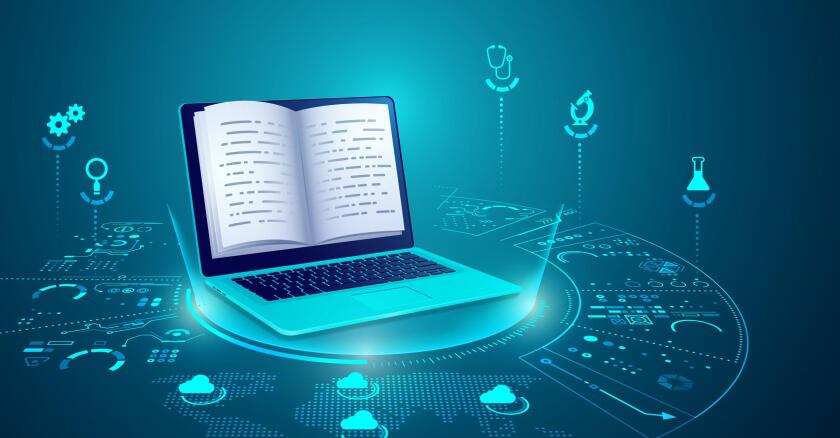
2024 technology Education technological
As we move into the digital age, technology continues transforming our lives and work. Technology significantly impacts education, where innovations are changing how we teach and learn.
This blog post will look at eight new trends in education technology that is likely to have a significant impact in 2023. Educators and students may prepare for the future of education by studying these trends and their possible outcomes.
Blended Learning
Blended learning combines traditional classroom instruction with digital learning. It allows students to engage with course materials both in-person and online, offering more flexibility and personalization for learners.
Here are some highlights of blended learning:
- Blended learning combines face-to-face classroom instruction with online learning experiences.
- It can be used in K-12 and higher education settings
- Students have more control over their knowledge and can access course materials online.
- Teachers can use online resources to supplement classroom instruction.
- Blended learning has the potential to improve student engagement and outcomes.
- It can be particularly effective for students who need more individualized attention or who have busy schedules.
- Blended learning can also prepare students for the digital skills required in today’s workforce.
Learning Analytics
Learning analytics is collecting and analyzing data on student learning and engagement. It provides insights to help educators improve their teaching and support student success by identifying areas where students may struggle or excel.
Here are some highlights of learning analytics:
- Learning analytics can help educators understand how students engage with course materials and identify areas where they may struggle.
- By analyzing data from student assessments, learning management systems, and other sources, educators can gain insights into student performance and use that information to make data-driven decisions.
- Learning analytics can also help educators identify at-risk students and provide them with targeted interventions to improve their outcomes.
- It can enhance personalized learning by allowing educators to tailor instruction to individual student needs.
- Learning analytics can also help institutions evaluate the effectiveness of their teaching and learning practices and make data-driven decisions to improve student outcomes.
Microlearning
Microlearning delivers learning content in small, bite-sized chunks, typically through digital platforms such as mobile apps or e-learning modules. It breaks down complex topics into manageable pieces, improving engagement and retention.
Here are some highlights of microlearning:
- Microlearning is used in various educational settings, including K-12 schools, colleges and universities, and professional development programs.
- It is often delivered through online modules, videos, or other interactive media.
- Microlearning can improve student engagement and retention by presenting information more digestibly.
- It lets students learn at their own pace and focus on specific topics of interest, helping increase motivation and interest in learning.
- Microlearning can also reinforce learning and help students retain information over time.
Personal Data Privacy
With the growing use of technology in education, protecting student data privacy is becoming increasingly important. Personal data privacy protects students’ sensitive personal information, such as their names, addresses, and academic records, from potential breaches.
Here are some highlights of personal data privacy:
- Schools and institutions are responsible for protecting their students’ data from unauthorized access or misuse.
- Data privacy regulations like GDPR and CCPA are becoming more common, and schools must comply.
- Schools can protect their students’ data by implementing secure data storage practices and using encryption and other security measures to prevent unauthorized access.
- Educators can also help protect their students’ privacy by being transparent about what data is collected and how it will be used.
- Students and parents have the right to access and control their data, and schools must provide them with this information.
- Personal data privacy is essential to building trust between schools, parents, and students and can help promote a safe and secure learning environment.
Cognitive Computing
Cognitive computing uses artificial intelligence to create more personalized and adaptive student learning experiences. It analyzes student data and behavior to provide tailored recommendations and support for each learner.
Here are some highlights of cognitive computing:
- Cognitive computing has the potential to personalize learning by analyzing data on student performance and tailoring instruction to individual needs and learning styles.
- It can help improve student outcomes by identifying areas where students may struggle and providing targeted interventions to address those challenges.
- Cognitive computing can also help educators identify patterns in student behavior and adjust instruction accordingly.
- There are many examples of cognitive computing-powered education tools, including adaptive learning platforms, chatbots that provide personalized support to students, and virtual tutors that provide one-on-one instruction.
- By automating routine tasks, cognitive computing can free educators’ time to focus on higher-level teaching and learning activities.
- Cognitive computing can also reduce bias in education by objectively assessing student performance.
3D Printing
3D printing is a technology that allows physical objects to be created from digital designs. In education, it can be used to develop models of complex concepts or prototypes of student inventions, allowing for hands-on learning and experimentation.
Here are some highlights of 3D printing in education:
- 3D printing is used in various educational settings, including K-12 schools, colleges and universities, and maker spaces.
- It can be used to create 3D models of complex objects, such as molecules or anatomical structures, that students can explore in more detail.
- It can also be used to create prototypes of inventions or designs created by students, allowing them to test and refine their ideas in a physical form.
- Providing students hands-on experience with 3D design and printing technology can help enhance their creativity and problem-solving skills.
- 3D printing can also enhance student engagement by making abstract concepts more concrete and tangible.
- It can potentially revolutionize fields such as engineering, architecture, and medicine by allowing students to create and test physical models of their designs.
Wearable Technology
Wearable technology refers to electronic devices or gadgets worn on the body, often smartwatches, fitness trackers, or augmented reality glasses. These devices can collect and transmit data about the user’s physical activity, health status, or location and are increasingly used in education to enhance the learning experience.
Here are some highlights of wearable technology in education:
- Wearable technology is used in education in various ways, such as tracking student activity and providing feedback on health and wellness.
- It can monitor student behavior and engagement, such as tracking attendance or measuring attention levels during class.
- Wearable technology can also create immersive learning experiences like virtual or augmented reality simulations.
- By providing real-time feedback to students, wearable technology can help enhance their learning experience and improve their performance.
- Wearable technology can also promote healthy habits and physical activity, such as tracking steps or reminding students to take breaks from studying.
Social and Emotional Learning
Social and emotional learning (SEL) involves the development of skills such as self-awareness, empathy, and communication, which are critical for success both in and out of the classroom. Technology can support SEL by providing tools for self-reflection, emotional regulation, and opportunities for collaboration and connection.
Here are some highlights of SEL in education:
- SEL can be integrated into education through explicit instruction, curriculum infusion, and school-wide practices and policies.
- It can help students develop positive relationships, empathy, and emotional regulation, enhancing their well-being and academic success.
- SEL can also improve the school climate and reduce negative behaviors such as bullying and aggression.
- By promoting positive social and emotional competencies, SEL can prepare students for success in college, career, and life.
- SEL has become increasingly important during the COVID-19 pandemic as students face increased stress and anxiety.
- As SEL continues to gain recognition and support, it has the potential to become a cornerstone of education and transform the way we support students’ holistic development.
Final Words
In conclusion, education technology rapidly evolves and transforms traditional teaching and learning methods. Educators and students should take advantage of these emerging trends and prepare themselves for the future of education by staying up-to-date with the latest developments and embracing the opportunities provided by these advancements in education technology. Academic coaching can be beneficial to guide educators and students toward achieving their goals through these emerging technologies.
Write and Win: Participate in Creative writing Contest & International Essay Contest and win fabulous prizes.


